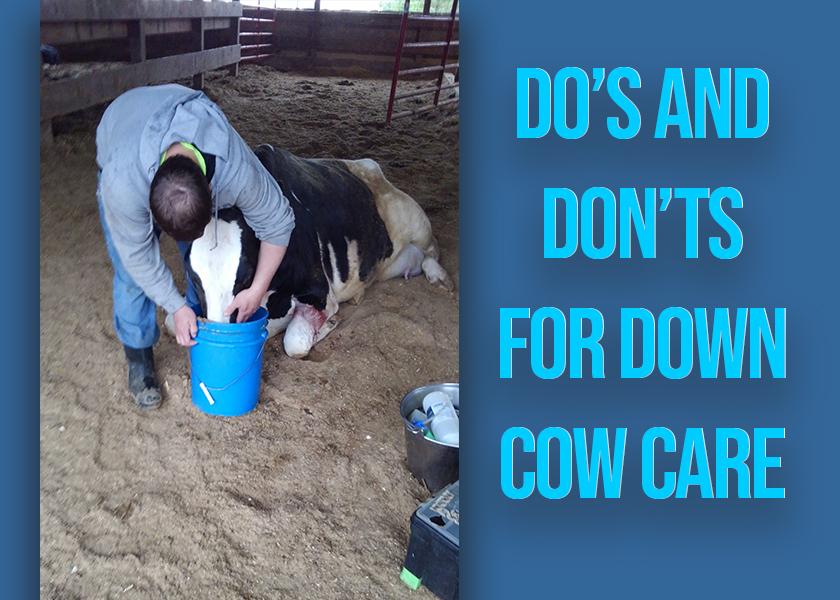Do’s and Don’ts for Down Cow Care

No one wants to have a down cow, but unfortunately it does occasionally happen. In a recent webinar, “Help Her When She’s Down: Best Practices for Down Cows,” veterinarian Shaw Perrin, Assistant Professor at The Ohio State University College of Veterinary Medicine, offered advice on how to best assist down cows, along with some practices to avoid.
Do:
- Treat the situation as an emergency. Down cows require immediate attention with assistance from a trained rescue team. Perrin suggested at least three adults are needed to safely move a down animal. Those individuals should preferably not be milker employees, because summoning their assistance will disrupt parlor operations.
- Assess the course of action. Why is she down? If she has a broken leg or other serious injury, or is severely dehydrated or unresponsive, immediate euthanasia may be in order. Cows in better condition in a safe location can be treated for their ailments immediately. If their housing situation is not as desirable, it is better to move them first before treating.
- Move her carefully to a comfortable spot. Down cows need a safe area in a pen or paddock where they have a comfortable resting surface, shade, and protection from the elements and predators. Make fresh water, feed, and hay available at all times.
- Use safe moving methods. Perrin listed sleds, harnesses, and bucket loaders as acceptable moving devices. When using a bucket loader, gently roll the cow into it, without using the bucket to reposition her. Beware of sharp edges, secure the cow’s head with a halter, and don’t stand below the bucket yourself.
- Provide supportive care. “It’s never wrong to give flunixin (Banamine®) for pain relief and offer fresh water immediately, even before moving her,” advised Perrin. Dexamethasone also can reduce pain, inflammation and swelling, but will cause abortion in pregnant animals. Additional, veterinary-prescribed treatments should be administered to treat the diagnosed condition (milk fever, toxic mastitis, etc.).
- Monitor progress. Check on down cows frequently, and document their condition using a handwritten treatment and movement record.
Don’t:
- Encourage her to rise on a slippery surface. This creates is a high likelihood of her falling and causing additional injury, and could make her fearful of attempting to rise again.
- Use abusive methods to encourage standing. According to the National Dairy F.A.R.M. program, “malicious use of high-pressure or high-volume water hoses on an animal’s face or head is considered ‘willful mistreatment.’”
- Do more damage while moving. “Never drag or lift a cow by her head or neck,” said Perrin. Hip lifters are acceptable for helping cows rise and walk under their own power, but should not be used to drag or hang cows. He also suggested using inexpensive, foam pool noodles to cushion hip lifters and avoid further injury.
- Allow down cows to linger. After 24 hours, is she more alert, able to sit up sternally, eating, drinking, resting comfortably and/or attempting to rise? If so, she may well be on the road to recovery. If the answer is “no” to most or all of these – or she remains in obvious pain due to teeth grinding, vocalizing, panting, or “paddling” – euthanasia is probably the best action.
Perrin advised working with a veterinarian to assess whether it is time to administer euthanasia. Approved euthanasia methods endorsed by the American Association of Bovine Practitioners are a gunshot to the head, penetrating captive bolt, or barbiturate overdose, all of which required skilled operator training to administer.







